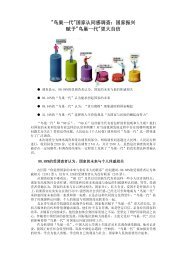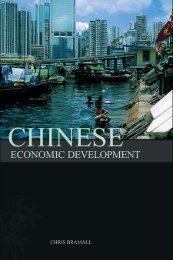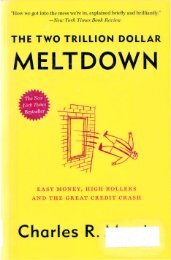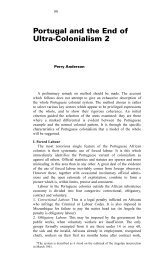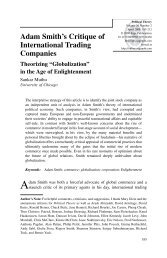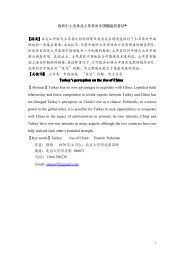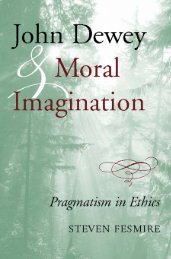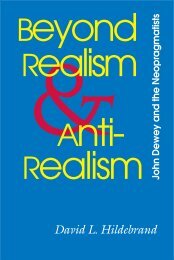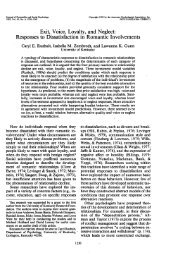Battle for China's Past : Mao and the Cultural Revolution
Battle for China's Past : Mao and the Cultural Revolution
Battle for China's Past : Mao and the Cultural Revolution
You also want an ePaper? Increase the reach of your titles
YUMPU automatically turns print PDFs into web optimized ePapers that Google loves.
THE BATTLE FOR CHINA’ S PAST<br />
Anhui; Yu Jianrong (2003) on Hunan; <strong>and</strong> Gao (2005) on Jiangxi <strong>and</strong><br />
Shanxi. The study focuses on <strong>the</strong>se provinces not only because this<br />
area is <strong>the</strong> rural heartl<strong>and</strong> that contains a large portion of China’s<br />
population, but also because, from <strong>the</strong> perspective of income <strong>and</strong><br />
development, it can be considered ‘middle ground’ between <strong>the</strong> more<br />
developed sou<strong>the</strong>ast coast <strong>and</strong> <strong>the</strong> less developed northwest.<br />
It is argued that even though many are better off in material terms<br />
such as food <strong>and</strong> clothing in <strong>the</strong> post-<strong>Mao</strong> era, social problems abound<br />
<strong>and</strong> <strong>the</strong> social fabric has been eroded by corruption, oppressive taxes<br />
<strong>and</strong> levies, crime <strong>and</strong> <strong>the</strong> unaf<strong>for</strong>dable cost of education <strong>and</strong> healthcare.<br />
For millions of Chinese from this rural heartl<strong>and</strong> poverty is still a<br />
problem, <strong>and</strong> <strong>the</strong> freedom of choice to work as a migrant is not necessarily<br />
an improvement in terms of quality of life <strong>and</strong> long-term<br />
well-being. During <strong>the</strong> <strong>Mao</strong> era life was basic <strong>and</strong> austere, material<br />
goods were scarce, <strong>and</strong> <strong>the</strong>re was hunger, but this was compensated<br />
<strong>for</strong> by a considerable measure of social equality, personal safety, <strong>and</strong> a<br />
better education <strong>and</strong> healthcare system. The chapter discusses <strong>the</strong> <strong>for</strong>m<br />
<strong>and</strong> content of resistance from rural China, <strong>and</strong> <strong>the</strong> way <strong>Mao</strong>ist radicalism<br />
has been an inspiration <strong>for</strong> rural resistance, thus providing a<br />
critical account of reaction to change in rural China since <strong>the</strong> re<strong>for</strong>ms.<br />
This chapter advances <strong>the</strong> idea that <strong>the</strong> urban–rural divide <strong>and</strong> related<br />
discriminatory policies against Chinese farmers are based on a developmental<br />
discourse which induces a kind of development that is<br />
detrimental to <strong>the</strong> environment <strong>and</strong> cannot be sustained.<br />
Chapter 10 presents an overall evaluation of <strong>the</strong> post-<strong>Mao</strong> re<strong>for</strong>ms in<br />
relation to <strong>the</strong> legacy of <strong>the</strong> <strong>Mao</strong> era. This evaluation addresses <strong>the</strong> issue<br />
of how different parts of Chinese society experience life differently today.<br />
Its findings present a cautionary picture of mixed results, less rosy than<br />
that portrayed in <strong>the</strong> media. It also enters <strong>the</strong> discourse which asks<br />
whe<strong>the</strong>r China is a capitalist country or a socialist country with Chinese<br />
characteristics. In discussing <strong>the</strong>se issues it first questions <strong>the</strong> premise of<br />
such a dichotomy, <strong>and</strong> second, it asks whe<strong>the</strong>r <strong>and</strong> in what way <strong>the</strong>se<br />
issues matter to <strong>the</strong> life of <strong>the</strong> ordinary Chinese. In this chapter, <strong>the</strong> ways<br />
transnational companies exploit Chinese cheap labour <strong>and</strong> <strong>the</strong> effects<br />
this exploitation has on <strong>the</strong> global economy <strong>and</strong> life of <strong>the</strong> ordinary<br />
Chinese are discussed. In this connection <strong>the</strong> concept of comprador is<br />
employed to explain <strong>the</strong> rise of <strong>the</strong> few rich who act as middlemen in this<br />
chain of capitalist globalization. The chapter fur<strong>the</strong>rs questions <strong>the</strong><br />
sustainability of <strong>the</strong> current economic development model.<br />
In <strong>the</strong> conclusion, legacies of <strong>the</strong> <strong>Mao</strong> era are fur<strong>the</strong>r discussed <strong>and</strong><br />
analysed, however briefly, so as to highlight <strong>the</strong> conceptual framework<br />
that binds various chapters of <strong>the</strong> book toge<strong>the</strong>r: <strong>the</strong> way <strong>the</strong> past (<strong>the</strong><br />
era of <strong>Mao</strong>) is understood depends on one’s values <strong>and</strong> beliefs in <strong>the</strong><br />
present.<br />
[ 12 ]





